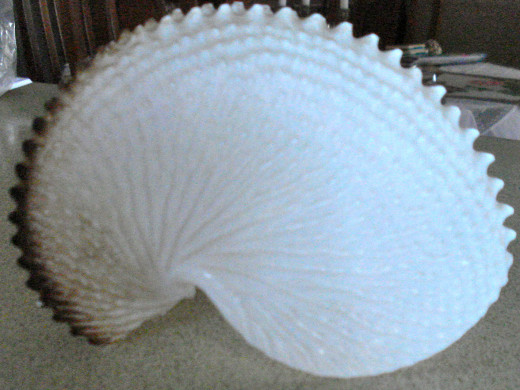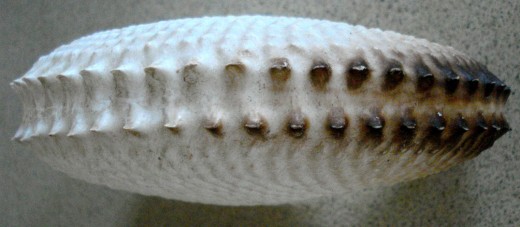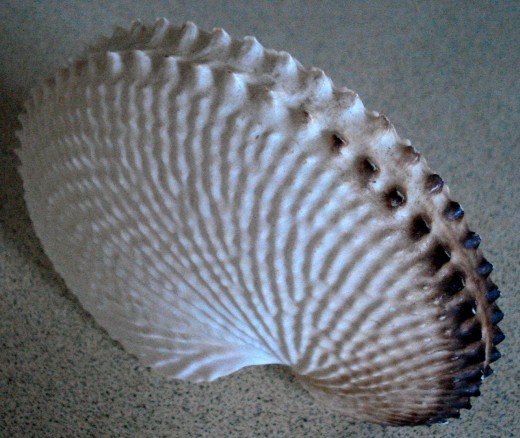The Paper Nautilus

Cephalopoda
In the Animalia Kingdom we find the Phylum of Mollusca. These are the molluscs that are invertebrates and include land animals such as slugs and snails, and sea animals like mussels and other animals that have a soft body and often an external protective shell.
The most highly developed molluscs are in the Class Cephalopoda. This Class covers marine creatures such as the octopus, squid and nautilus. The word is interesting as it comes from two words that mean "head-footed," as the tentacles are considered to be a type of mollusc foot, but they are attached to a structure that includes their highly developed eyes and brain: what we think of as the head!
Cephalopods have heads with eight or more tentacles. They have been around for a long time as many different types that are now extinct have been found as fossils and there are only a few hundred species left.
The Genus Argonauta
The Genus Argonauta are known as argonauts, a word that means 'sailor on the Argo.' Argos was a very important ancient Greek city that was built near the sea. Argonauts belong to the Order of Octopoda and are known as pelagic octopuses, or nautilus that live in the ocean.
The paper nautilus is a type of octopus and does not have a shell. It has a rounded body, eight tentacles and where most octopuses live on the seabed, the paper nautilus stays close to the surface. There are both male and female paper nautilus. The male is usually only about 2 cm, while the female is five times bigger, about 10 cm. The paper nautilus is carnivorous, feeding during the day on other molluscs, crustaceans, fish and jellyfish. They use their tentacles to catch their prey and then bite it, injecting a poison to paralyze it. The jaws of the nautilus are strong and can inflict a nasty bite on humans. In turn, the paper nautilus may become food for larger predators such as tuna and dolphins.
These marine animals were originally called nautilus, meaning 'sailor,' because it was thought that their special 'arms' were used as sails when they moved on the surface of the sea. It was later found that the arms were used by female paper nautilus to secrete the beautiful, very thin and delicate shell to protect her eggs. It is really an egg-case, rather than a shell; it usually measures around 30 cm. The male does not make an egg-case.

The Paper Nautilus and Reproduction
The tiny male was only discovered in the 1800s. He has a special arm that is inserted into the female's pallial cavity to transfer his sperm to the female. Then the arm breaks off and the male dies. His life-span is short, but the female lives considerably longer, usually mating several times and rearing numerous broods.
The female then produces the beautifully sculptured egg-case, complete with a bubble of air so that it floats. She deposits her eggs in it and also makes it her home so she can protect her eggs. She guards the entrance and curls around the outside, but will withdraw inside if frightened. Like her cousin the squid, she can change her colour or produce a paralyzing ink in an attempt to escape from predators.
Mt. Eliza is Between Frankston and Mornington
The Paper Nautilus and Climate Change
The paper nautilus egg-case in the accompanying photographs was found with a dying female some years ago on some rocks at Mt. Eliza on the Mornington Peninsula of Port Phillip Bay, Victoria, Australia. All the literature consulted on the topic state that the paper nautilus is found in tropical and sub-tropical waters; for Eastern Australia that means to just south of the Tropic of Capricorn, which is -23.26. Brisbane is -27.29 and the latitude of Melbourne is -37.49; Mt. Eliza is -38.194, well south of sub-tropical waters. Perhaps it had blown off course and was drawn into the warmer waters of the bay as the average temperature there is 15.8C compared with 15.0C of the ocean outside.
It has been proposed by some marine scientists that due to the unique method of making the thin egg-case, global warming and the increasing pH of the ocean may contribute to causing the shell to dissolve, thus causing the beautiful, interesting paper nautilus to be at risk of extinction.

Join This Poll
Have you ever seen a paper nautilus egg-case in the wild?
Shells of the Sea
- Helmet Seashells
The Helmet seashell is a member of the Superorder of Caenogastropoda, as is a smaller member of the Helmet family, the Bonnet seashell. Because they have been attractive to tourists and collectors and some species are now protected in Australia. - Cowrie Seashells
Cowries are a species of marine molluscs and have been utilised by man for over nine thousand years. Some species, although beautiful, are very common while others are extremely rare.







